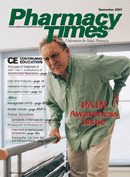Publication
Article
Pharmacy Times
Hypertension Watch
Office BP Readings Problematic?Home Monitoring Preferred
Several presentations at the recent 22nd Annual ScientificMeeting of the American Society of Hypertension echoedthe same message. The measurement of blood pressure(BP) during a physician visit is laden with problems.
The American Heart Association guidelines call for BP tobe measured at least 5 minutes after patients arrive for theirvisit or while they are sitting down with their arm supported.The guidelines, however, are not usually followed.
As a result, some cases of hypertension are missed orsome patients are misclassified. The findings emphasizedthe need for patients to monitor their BP at home to determineif they are at risk for morning hypertension. For informationon these presentations, visit www.morningbp.com/pt16Home BP Monitoring Is MoreReliable
A study, reported in the American Journal of Hypertension(May 2007), found that home blood pressure (BP) monitoringis more useful, compared with physician?s office readings and24-hour BP monitoring for tracking heart risk. For the study,163 patients underwent 24-hour ambulatory BP monitoring.The following day, 3 BP measurements were taken at thephysician?s office. The patients then took their BP at home inthe morning and the evening.
Overall, ?home monitoring is the best way of looking atchanges over long periods of time? and for giving data neededfor medication adjustments, commented study authorThomas Pickering, MD. For information on this study, visitwww.morningbp.com/pt18Nocturnal BP Dipping Raises Heart Risk
A new study examining the predictive value of circadianblood pressure (BP) variations in 1472 treated patients withhypertension suggested that patients with either no orextreme nighttime dips in BP face greater cardiovascularrisk, compared with patients with moderate change.
The study included 338 patients with a moderate dippingBP pattern, 745 patients with no dipping pattern in BP, and339 patients with extreme BP dipping. BP was assessedusing a 24-hour ambulatory BP monitoring system. Theresults indicated that 116 cardiovascular events occurred,with a greater number of events in the nondipping andextreme-dipping groups.
Because the rise in BP in the morning is associateddirectly with stroke risk, the findings reinforced the needfor patients to be active participants in treating their conditionby monitoring their BP at home. The findings wererecently presented at the 22nd Annual Scientific Meeting ofthe American Society of Hypertension. For more informationon morning hypertension, visit www.morningbp.com/pt17Improved BP Education Is Needed
A majority of patients with hypertensionunderstand that increased bloodpressure (BP) is a major risk for cardiovasculardisease. An online questionnairecompleted by 1245 hypertensivepatients found that >90% correctlyassociated high BP with heart attacksand stroke. The study also found, however,that misconceptions related tohypertension are common.
Of the respondents, 12% (and nearly25% of all blacks) still believe that highBP means an individual is tense or anxious.Approximately 25% of the respondentsincorrectly believe that weightloss is enough to reduce BP. The findingsunderscore the need for bettereducation on high BP and the importanceof monitoring BP on a regularbasis. The data were recently presentedat the 22nd Annual Meeting of theAmerican Society of Hypertension. Forinformation on the data, visit www.morningbp.com/pt19Hypertension: One Billion and Counting...
An analysis of the global impact of high blood pressure (BP)found that almost 1 billion people worldwide have the condition.Researchers are hoping that the statistics will pushworld governments to fight high BP.
Experts assembled 2 teams of specialists to map whatthey are calling the ?coming crisis of hypertension.? Thegroup recently provided copies to governments and healthofficials around the globe, which called for a cultural change.The increase in BP problems is being fueled by the world?spopulation aging and getting fatter. Surprisingly, the reportcited worse hypertension rates in much of Western Europe,compared with the United States. The most significantincrease is forecast for developing countries and nationsquickly moving to more Western-style economies, warnedthe experts. Therefore, hypertension needs to be addressedacross all populations, and strategies are needed to curtailthis growing problem. For information on morning hypertension,visit www.morningbp.com/pt20







